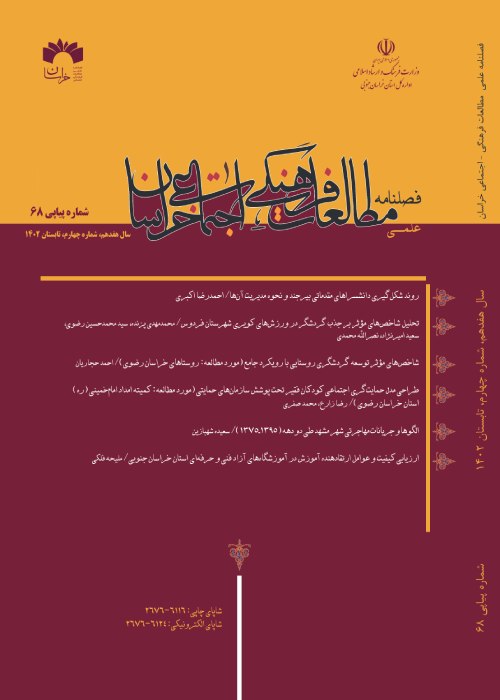The Study of the Decorations Related to the Architecture of the Room and Hosseinieh of Arasteh in Birjand (Era of Qajar and First Pahlavi)
Author(s):
Abstract:
In the architectural art of Qajar era، plastering and in the architectural art of first era of Pahlavi (1840-1941)، brickwork is so prominent. The Room of Arasteh is among the buildings of Qajar era which is located in Birjand and for its various designs and symbolic plastering is worth of inspecting and analyzing. The most famous decorations of this building includes; the herbal designs from various flower and palm، arabesque and arabesque frame leaves، the sun design، lion and dragon fight، strings of plaster، the figures of vaults and shady arcades. The Hosseinieh of Arasteh is among the buildings of first Pahlavi era in Birjand which contains very diverse bricklaying and outstanding brick stratifications like plug، cruciform، forked and religious plastered epigraphs and motifs of double lion. The question of the present research reveals that ever now no serious investigations has been accomplished concerning to this two historic buildings except some reports from cultural heritage organization and historical texture base center of Birjand city. This two historic buildings in spite of their rich architectural decorations has not been presented comprehensively and its decorations actually were not analyzed or inspected carefully. So the aim of the present article is the introduction of these two prestigious buildings but unknown in the Northeast’s cultural hub of the country and also the investigation of these two buildings motifs and purports. The findings of this research reveals that plastering designs of the Room of Arasteh derived from the Sassanid plastering art. The Hosseinieh of Arasteh according to its religious function، exploited from the motifs of religious purports such as epigraphs traditions and double lion design carvings in two sides of their inscriptions. Motifs like the sun design، the lion motifs and the lion and dragon fight are among the key designs of this two buildings which beside their historical background، hold symbolic and religious concepts. The data collection method is from library sect and directions is being taken from experienced craftsmen of South Khorasan and picture samples attained from the two buildings photography. The research methodology is descriptive-analytic and in some cases is in comparative model.
Keywords:
Language:
Persian
Published:
Scientific Quarterly of Social-Cultural Studies of Khorasan, Volume:9 Issue: 4, 2015
Page:
29
magiran.com/p1487122
دانلود و مطالعه متن این مقاله با یکی از روشهای زیر امکان پذیر است:
اشتراک شخصی
با عضویت و پرداخت آنلاین حق اشتراک یکساله به مبلغ 1,390,000ريال میتوانید 70 عنوان مطلب دانلود کنید!
اشتراک سازمانی
به کتابخانه دانشگاه یا محل کار خود پیشنهاد کنید تا اشتراک سازمانی این پایگاه را برای دسترسی نامحدود همه کاربران به متن مطالب تهیه نمایند!
توجه!
- حق عضویت دریافتی صرف حمایت از نشریات عضو و نگهداری، تکمیل و توسعه مگیران میشود.
- پرداخت حق اشتراک و دانلود مقالات اجازه بازنشر آن در سایر رسانههای چاپی و دیجیتال را به کاربر نمیدهد.
In order to view content subscription is required
Personal subscription
Subscribe magiran.com for 70 € euros via PayPal and download 70 articles during a year.
Organization subscription
Please contact us to subscribe your university or library for unlimited access!



